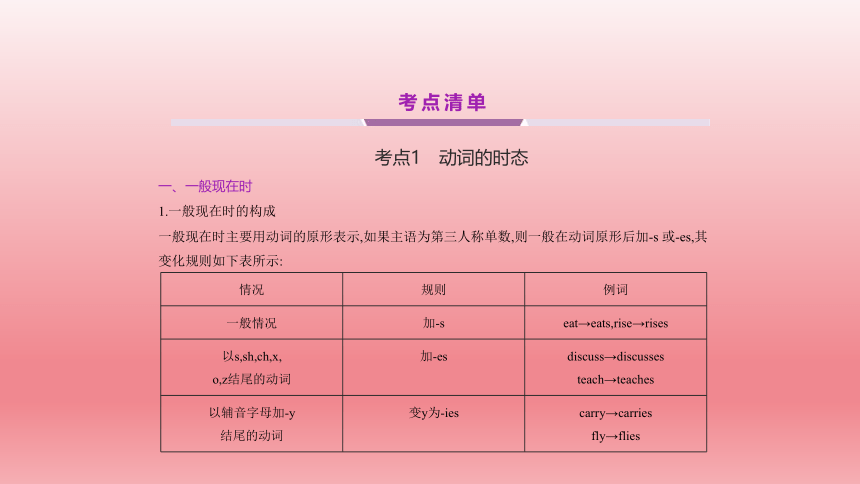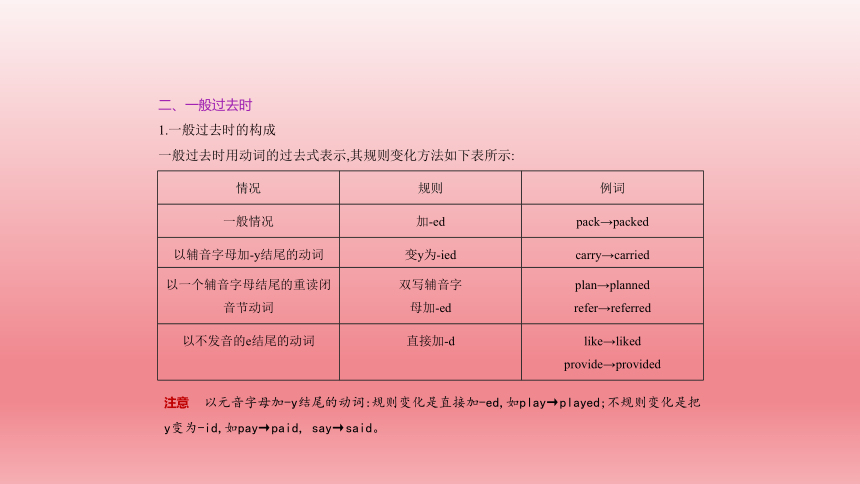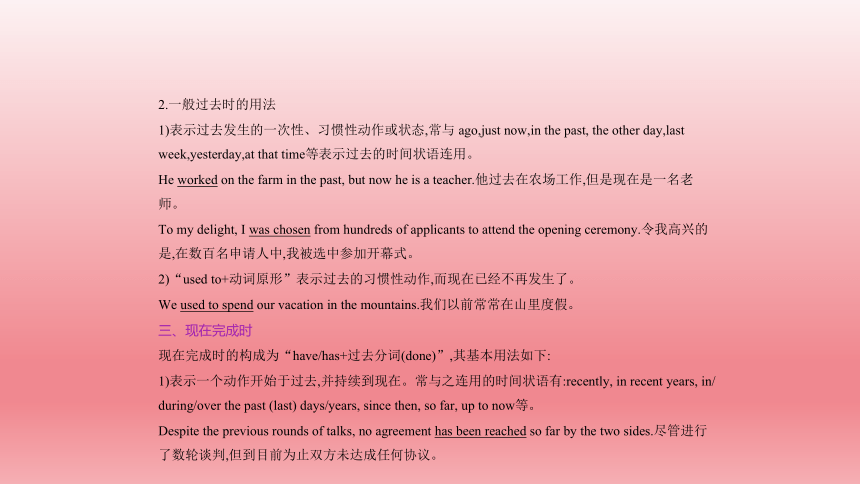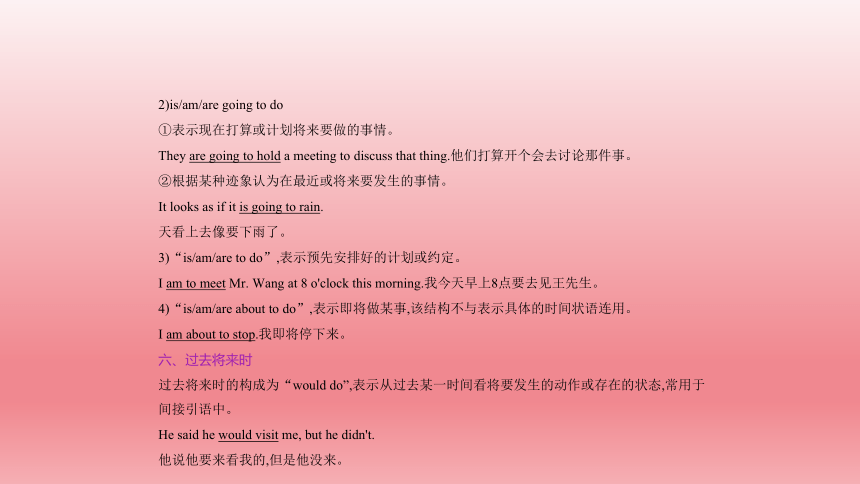2024届高考英语复习专题:谓语动词课件(共25张PPT)
文档属性
| 名称 | 2024届高考英语复习专题:谓语动词课件(共25张PPT) |  | |
| 格式 | pptx | ||
| 文件大小 | 668.1KB | ||
| 资源类型 | 教案 | ||
| 版本资源 | 通用版 | ||
| 科目 | 英语 | ||
| 更新时间 | 2023-12-18 17:35:00 | ||
图片预览









文档简介
(共25张PPT)
2024届高考英语复习专题★★ 谓语动词
2024届高考英语复习专题★★
考点1 动词的时态
一、一般现在时
1.一般现在时的构成
一般现在时主要用动词的原形表示,如果主语为第三人称单数,则一般在动词原形后加-s 或-es,其
变化规则如下表所示:
考点清单
情况 规则 例词
一般情况 加-s eat→eats,rise→rises
以s,sh,ch,x, o,z结尾的动词 加-es discuss→discusses
teach→teaches
以辅音字母加-y 结尾的动词 变y为-ies carry→carries
fly→flies
2.一般现在时的用法
1)表示现在的经常性、习惯性动作或状态。
We have meals three times a day.
我们一日吃三餐。(现在的习惯)
I am a Senior Three student whose name is Li Hua.我是一名高三学生,名叫李华。(现在的状态)
2)表示客观真理、科学事实及自然现象。 此用法即使出现在过去的语境中,也用一般现在时。
The Earth revolves around the Sun.
地球绕着太阳公转。
He said that hydrogen is a light gas.
他说氢气是一种很轻的气体。
3)在时间、条件、让步状语从句中,主句为一般将来时,而从句常用一般现在时表将来。
If you don't work hard, nobody will give you the life you want.如果你不努力,谁也给不了你想要的生
活。
4)表示按时刻表发生的动作,用一般现在时表将来。
The train leaves at 9:00. I'll reach the station by 8:40.火车9点出发。我将在8:40前到车站。
二、一般过去时
1.一般过去时的构成
一般过去时用动词的过去式表示,其规则变化方法如下表所示:
情况 规则 例词
一般情况 加-ed pack→packed
以辅音字母加-y结尾的动词 变y为-ied carry→carried
以一个辅音字母结尾的重读闭音节动词 双写辅音字 母加-ed plan→planned
refer→referred
以不发音的e结尾的动词 直接加-d like→liked
provide→provided
注意 以元音字母加-y结尾的动词:规则变化是直接加-ed,如play→played;不规则变化是把
y变为-id,如pay→paid, say→said。
2.一般过去时的用法
1)表示过去发生的一次性、习惯性动作或状态,常与 ago,just now,in the past, the other day,last
week,yesterday,at that time等表示过去的时间状语连用。
He worked on the farm in the past, but now he is a teacher.他过去在农场工作,但是现在是一名老
师。
To my delight, I was chosen from hundreds of applicants to attend the opening ceremony.令我高兴的
是,在数百名申请人中,我被选中参加开幕式。
2)“used to+动词原形”表示过去的习惯性动作,而现在已经不再发生了。
We used to spend our vacation in the mountains.我们以前常常在山里度假。
三、现在完成时
现在完成时的构成为“have/has+过去分词(done)”,其基本用法如下:
1)表示一个动作开始于过去,并持续到现在。常与之连用的时间状语有:recently, in recent years, in/
during/over the past (last) days/years, since then, so far, up to now等。
Despite the previous rounds of talks, no agreement has been reached so far by the two sides.尽管进行
了数轮谈判,但到目前为止双方未达成任何协议。
2)表示过去发生的事情对现在产生的影响。常用的时间状语有:already, ever, just, yet, before等。
He has just turned off the light.(=The light is off now.)他已经关掉灯了。
The concert has already started.(=The concert is on now.)音乐会已经开始了。
3)“最高级+名词”或“It/This is+the+序数词+time”后的从句中谓语动词常用现在完成时。
This is the best tea (that) I have ever drunk.这是我喝过的最好的茶了。
This is the first time (that) I have come here.这是我第一次来这里。
四、现在完成进行时
现在完成进行时的构成为“have/has been doing”,表示从过去某一时间开始一直持续到现在(该
动作可能刚停止,也可能还在进行),也可表示现在的状态,有时表示动作的重复等。
Since the time humankind started gardening, we have been trying to make the environment more beau-
tiful.自从人类开始做园艺工作以来,我们一直在努力使环境变得更美。
Look! It has been raining like this for three hours.瞧!雨这样下了三个小时了。
五、一般将来时
1)“will/shall do”,表示将来的动作或状态,常与next year, tomorrow, soon, in the future等表示将来
的时间状语连用。
Don't worry. The hard work that you do now will be repaid someday in the future.
别担心,你现在所付出的努力未来某一天会得到回报。
2)is/am/are going to do
①表示现在打算或计划将来要做的事情。
They are going to hold a meeting to discuss that thing.他们打算开个会去讨论那件事。
②根据某种迹象认为在最近或将来要发生的事情。
It looks as if it is going to rain.
天看上去像要下雨了。
3)“is/am/are to do”,表示预先安排好的计划或约定。
I am to meet Mr. Wang at 8 o'clock this morning.我今天早上8点要去见王先生。
4)“is/am/are about to do”,表示即将做某事,该结构不与表示具体的时间状语连用。
I am about to stop.我即将停下来。
六、过去将来时
过去将来时的构成为“would do”,表示从过去某一时间看将要发生的动作或存在的状态,常用于
间接引语中。
He said he would visit me, but he didn't.
他说他要来看我的,但是他没来。
They made up their mind that they would build a new house.他们下决心要建一所新房子。
七、现在进行时
现在进行时的构成为“is/am/are doing”,其基本用法如下:
1)表示现在或现阶段正在进行的动作和发生的事情。
Now I am planning our schedule for the trip.现在我正在计划我们的旅行日程。
2)与always, constantly, continually等副词连用表示赞赏、厌恶、遗憾等感情。
Maria is always thinking of others instead of herself.
玛丽亚总为别人着想,而不为自己着想。
3)动词come,go,leave,stay,fly,arrive,begin,start,take等可用进行时表将来。
I am flying to New York this afternoon.
今天下午我将乘飞机去纽约。
八、过去进行时
过去进行时的构成为“was/were doing”,表示过去某一时刻或某阶段正在发生的动作。
The last time I saw Jane, she was picking cotton in the fields.
我上一次见到简时,她正在地里摘棉花。
They are living with their parents for the moment because their own house was being rebuilt.目前他们
与父母生活在一起,因为他们自己的房子正在重建。
九、将来进行时
将来进行时的构成为“will/shall be doing”,表示将来某一时刻正在进行的动作。
Jane can't attend the meeting at 3 o'clock this afternoon because she will be teaching a class at that
time.简无法参加今天下午三点钟的会议,因为那时她正在授课。
十、过去完成时
过去完成时的构成为“had done”,其基本用法如下:
1)一件事情发生在过去,而另外一件事情先于它发生(即表示“过去的过去”),那么发生在前的动
作要用过去完成时。
Just as I got to the school gate, I realized I had left my book in the cafe.正当我到达校门口的时候,我
才意识到我把书落在了小饭馆。
2)表示从过去某一时间开始,一直延续到过去的另一时间的动作,常用的时间状语有:by/until/be-
fore/by the end of+过去的某一时间。
By then he had learned English for 3 years.到那时,他已学了3年英语了。
Until then he had known nothing about it yet.到那时为止,他对此仍一无所知。
3)hope,expect,mean,intend,want,suppose等词可用过去完成时表示过去未曾实现的愿望或意图。
I had hoped to see more of Shanghai.我本希望在上海多看看。(但未能如愿)
I had intended to visit you, but someone came to see me just when I was about to leave.我本打算去看
你,但是正要出发时有人过来看我。
4)在“hardly/scarcely/barely...when...”和“no sooner...than...”句型中,when和than后的从句用一
般过去时,主句用过去完成时,表示“一……就……”。当否定副词hardly, scarcely, barely, no
sooner等放在句首时,主句用部分倒装。
I had hardly/no sooner got home when/than the rain poured down.=(Hardly/No sooner had I got home
when/than the rain poured down.)我刚一到家,大雨就倾盆而下。
5)在“That/It/This was+the+序数词+time+that从句”中,that从句的谓语要用过去完成时。
It was the third time (that) he had made the same mistake.
那是他第三次犯同样的错误了。
考点2 被动语态
一、常考被动语态的构成
1)一般现在时的被动语态:is/am/are done
In Southeast Asian culture, a smile is used frequently to cover painful feelings.在东南亚文化中,微笑
常常被用来掩饰痛苦的感情。
2)现在进行时的被动语态:is/am/are being done
We haven't moved into the new house,because the walls are being painted now.我们还没有搬进新房
子,因为墙壁现在正在粉刷。
3)现在完成时的被动语态:have/has been done
The company's assets have been frozen.
这家公司的资产已被冻结。
4)一般过去时的被动语态:was/were done
Five reporters were sent to cover the conference.五名记者被派去报道这次会议。
5)过去进行时的被动语态:was/were being done
She was terrified to find that she was being followed by a stranger.
发现被陌生人跟踪,她很害怕。
6)过去完成时的被动语态:had been done
When she got home,she found her English textbook had been left in the classroom.
到家时,她发现英语课本落在了教室。
7)一般将来时的被动语态:will/shall be done
You will be abandoned by your fans.
你将被你的粉丝抛弃。
8)过去将来时的被动语态:would be done
He said he would be promoted.他说他会被提升。
9)含情态动词的被动语态:情态动词+be done
He must be prevented from going.
必须阻止他去。
二、可用主动形式表示被动含义的动词
1)某些与can't, won't等连用的不及物动词,如open, move, shut等。
The door won't shut.这扇门关不上。
2)某些可和well, easily等副词连用的不及物动词,如read, write, draw, wash,clean, cook等。
Nylon cleans easily.
尼龙容易洗干净。
Your article reads very well.
你的文章读起来很不错。
三、不能用于被动语态的动词或动词短语
1.系动词
1)表示感官的系动词:look(看起来),sound(听起来),smell(闻起来),taste(尝起来),feel(摸起来,感觉)。
The apple tastes good.
这个苹果尝起来不错。
The material feels soft.
这种材料摸起来柔软。
2)表示状态的系动词:keep/remain/stay(保持)。
You should keep quiet in class.
你应该在课堂上保持安静。
3)表示变化的系动词:become(变成),get/turn/go/grow(变得)。
With the approaching of spring,the weather gets warmer and warmer.随着春天的到来,天气越来越暖
和。
2.不及物动词或动词短语(本身意义完整,后面不必跟宾语的实义动词):
arrive,break out(爆发),come,die,fall,run,rise,last(持续),take place(发生)等。
In the past three decades, great changes have taken place in my hometown.30年以来,我的家乡发生了
巨大的变化。
3.不能用于被动语态的及物动词或动词短语:
belong to(属于),cost(花费),date back to(追溯到),have(有),succeed in(在……方面成功),suffer from
(受……之苦),take part in(参加),wish(希望)等。
The house belongs to my uncle.
房子是属于我叔叔的。
Shaolin Temple dates back to the Northern Wei Dynasty.
少林寺可追溯到北魏时期。
考点3 主谓一致
主谓一致,即在句子中谓语动词的数必须和主语的数保持一致。一般可根据三个原则来确定:
1)语法一致:主语的单、复数决定谓语动词的形式;
2)就近一致:谓语动词要和离它最近的主语在数上保持一致;
3)意义一致:形单意复或形复意单的名词作主语,谓语动词要根据主语的意义决定。
一、语法一致
1)可数名词单数或不可数名词作主语,谓语动词使用单数形式;可数名词复数作主语,谓语动词使
用复数形式。
The results of the research are to be published soon.研究结果不久将被发表。
2)不定式、动名词和从句作主语,谓语动词一般用单数。what引导的主语从句作主语时,谓语动词
的单复数取决于作表语的名词的单复数。
Swimming in summer is a good sport.
夏天游泳是一项很好的运动。
What we need is more money, but what they need are books.我们需要的是更多的钱,但是他们需要
的是书。
3)如果主语后面带有as well as, with, along with, together with, rather than, but, except, besides, in-
cluding, in addition to等加其他名词时,谓语动词的数要与前面的主语保持一致。
Pronunciation, as well as grammar and vocabulary, changes from one area to another.发音与语法和词
汇一样,因地区差异而变化。
4)a number of+名词复数+谓语动词的复数形式(许多); the number of+名词复数+谓语动词的单数
形式(……的数量)。
A number of students are from the south.
不少学生来自南方。
The number of students from the north is small.来自北方的学生人数很少。
5)复合不定代词someone, anyone, everyone, nobody/no one, something, anything, everything, nothing
等作主语,谓语动词用单数。
If anyone sees Lisa, ask her to call me.
如果有人看到莉萨,让她给我打个电话。
Nothing is impossible to a willing heart.
世上无难事,只怕有心人。
6)each of+名词复数/them/us/you作主语时,谓语动词用单数形式,但“名词复数/they/we/you+
each”作主语时,谓语动词用复数形式。
Each of the students has an apple.这些学生每人有一个苹果。 (不定代词Each作主语)
The students each have an apple.这些学生每人有一个苹果。(The students作主语,each作同位语)
7)代词all作主语:若指人,谓语动词用复数;若指事物或现象,谓语动词通常用单数。
All are equal before the law.
法律面前,人人平等。
All is well that ends well.
结局好一切都好。
8)many a/the whole/each/every/either/neither+单数名词作主语,谓语动词用单数。
Many a page in this book is missing.
这本书缺了许多页。
The whole nation is in deep sorrow at the news.听到这个消息,全国人民沉浸在悲痛之中。
二、就近一致
1)由or,either...or...,neither...nor...,not only...but also...,not...but...等连接并列主语时,谓语动词的单复
数和离它最近的主语在人称和数上保持一致。
Marilyn or you are to blame for the fault.
要么玛丽莲要么你应为这个过失负责。
2)There be句型中,主语是两个或多个并列名词时,be的形式与最邻近的主语保持一致。
There is a desk, three chairs and a computer in my new office.在我的新办公室里有一张桌子、三把
椅子和一台电脑。
三、意义一致
1)分数,百分数,half,the rest或most of+名词作主语时,谓语动词需与of后的名词保持一致。
About one-third of the books are worth reading.这些书中大约有1/3值得一读。
Two thirds of the region has been deforested in the past decade.在过去十年里这个地区的森林有三分
之二被毁掉。
2)形式为单数但意义为复数概念的police, cattle等作主语时,谓语动词用复数。
The police have not made any arrests.
警方未逮捕任何人。
3)表示一类人的the poor/rich/dead/injured/wounded等和the+姓氏复数作主语时,谓语动词用复数。
The rich are to help the poor.
富人应该帮助穷人。
The Greens are going to London.
格林一家要去伦敦。
4)单复数同形的名词sheep, deer, means等作主语时,谓语动词的数与实际意义一致。
Three sheep are eating grass there.
三只羊正在那里吃草。
A sheep is lying there.有只羊正躺在那里。
5)集体名词family, class, crew, team, group, public, audience, crowd, government, committee等作主
语时,谓语动词的单复数要根据主语所指的意义而定。 当集体名词作为一个整体看待时,谓语动
词用单数;如果指其中各个成员时,谓语动词用复数。
The class consists of twenty-five boys and twenty girls.这个班由25个男生和20个女生组成。(强调
class这一整体)
The class are doing experiments.全班学生正在做实验。(强调class里的各个成员)
6)带有并列动词的what从句作主语时,要根据意义一致的原则决定谓语动词的单复数。
What he says and does do not agree.
他言行不一致。
What he says and does does not concern me.他的言行与我无关。
四、其他主谓一致问题
1)两个单数名词用and连接,表示同一人、同一物时,谓语动词仍用单数。
The singer and dancer is to attend our evening party.
那位歌舞演员将参加我们的晚会。
2)被every, each, many a, no等限定的单数名词由and连接时,谓语动词仍用单数。
Every teacher and (every) student has seen the film.每个老师和学生都看过这部电影。
3)表示时间、重量、距离、价格、体积等名词的复数作主语时,通常当作整体看待,后接谓语动词
的单数形式。
Twenty years is a long time in one's life.
20年在人的一生中是很长的一段时间。
4)由“kind/form/type/sort of +名词”作主语,其谓语形式取决于of前的这些词的单复数形式。
The new type of buses is now on show.(=Buses of the new type are now on show.)
现在正展出这种新型的公共汽车。
5)如果主语由“more than one+名词”构成,尽管从意义上看是复数,但谓语动词用单数。
More than one student has failed the exam.
不止一个学生考试不及格。
6)定语从句中的谓语动词在人称和数方面应该与其先行词保持一致。
This is one of the novels that have ever been written by Mo Yan.
这是莫言所写的小说之一。
She is the only one of the girls who sings well in class.
她是班里女生中唯一唱歌好的。
7)在强调句型“It is/was+被强调部分+that/who+其他成分”中,当被强调部分是句子主语时,“其
他成分”中的谓语动词需和被强调的主语保持一致。
It is I who am a teacher.我才是老师。
It is the boys who are responsible for the accident.这些男孩应为这次事故负责。
考点4 情态动词
情态动词表示说话人的语气和态度,具有一定的词义,但不能单独作谓语,它们要和行为动词或连
系动词的原形连用构成谓语。
一、情态动词的基本用法
1.can/could
1)表示一般的能力。
Mary can speak three languages.
玛丽能说3门语言。
2)请求、允许(could比can语气更委婉)。
—Can/Could you help me 你能帮我吗
—Yes,I can.可以。
3)can't表推测,意为“不可能”。
That can't be true.
那不可能是真的。
2.may/might
1)表示请求或允许,意为“可以”。
You may leave the book where it was.你可以把书放在原来的位置。
2)may, might表推测,用于肯定句,意为“可能”;may/might not意为“可能不”。
You may be right or may not be right.
你可能对也可能不对。
3.must
表示必要性,意为“必须”,其否定回答为needn't/don't have to;否定式mustn't表示“禁止”。
—Must I give up smoking 我必须戒烟吗
—Yes, you must.是的,你必须戒烟。
—No, you needn't/don't have to.不,你不必戒烟。
You mustn't smoke here.你不可以在这里吸烟。
4.should
1)表示义务上的“应该”。
You should(=ought to) be listening.你应该听才对。
2)表示推测上的“按说应该”。
He should(=ought to) arrive by now.
现在他按说应该到了。
3)表示“居然,竟然”。
It is unthinkable that he should be so careless.真不可思议,他竟然如此粗心大意。
二、“情态动词+have done”的用法
1)must have done想必做了;一定做了
It must have rained last night, for the ground is quite muddy.昨晚一定下雨了,因为地面很泥泞。
2)could have done本来能够做而实际上没做
You could have stayed at my house last night.
你昨晚本来可以待在我家的。
3)can't/couldn't have done不可能做过
He can't have forgotten it.
他不可能忘了那件事。
4)may/might have done也许/或许已经做了,一般只用于肯定句或否定句中(在否定句中表示“可能
不”),不用于疑问句,用might则表示语气更弱。
It's too late. I think he may have gone to bed.太晚了,我想他或许已经睡了。
He may not have finished the work.他也许还没完成那项工作。
5)should/ought to have done 本该做而实际上未做
You ought to have done this exercise more carefully.你本应该更仔细地做这个练习。
6)should not/ought not to have done 本不该做而做了
You shouldn't have told her the truth.
你本不该告诉她真相。
7)needn't have done 本不必做而做了
You needn't have taken a taxi here, for it is very near to your house.你本来不必打车来这里的,因为这
里离你家很近。
8)would like/love to have done 过去愿意做但未做成
I would love to have gone to the party last night, but I had to work extra hours to finish the report.昨晚我本来很想去参加聚会的,但我得加班完成报告。
2024届高考英语复习专题★★ 谓语动词
2024届高考英语复习专题★★
考点1 动词的时态
一、一般现在时
1.一般现在时的构成
一般现在时主要用动词的原形表示,如果主语为第三人称单数,则一般在动词原形后加-s 或-es,其
变化规则如下表所示:
考点清单
情况 规则 例词
一般情况 加-s eat→eats,rise→rises
以s,sh,ch,x, o,z结尾的动词 加-es discuss→discusses
teach→teaches
以辅音字母加-y 结尾的动词 变y为-ies carry→carries
fly→flies
2.一般现在时的用法
1)表示现在的经常性、习惯性动作或状态。
We have meals three times a day.
我们一日吃三餐。(现在的习惯)
I am a Senior Three student whose name is Li Hua.我是一名高三学生,名叫李华。(现在的状态)
2)表示客观真理、科学事实及自然现象。 此用法即使出现在过去的语境中,也用一般现在时。
The Earth revolves around the Sun.
地球绕着太阳公转。
He said that hydrogen is a light gas.
他说氢气是一种很轻的气体。
3)在时间、条件、让步状语从句中,主句为一般将来时,而从句常用一般现在时表将来。
If you don't work hard, nobody will give you the life you want.如果你不努力,谁也给不了你想要的生
活。
4)表示按时刻表发生的动作,用一般现在时表将来。
The train leaves at 9:00. I'll reach the station by 8:40.火车9点出发。我将在8:40前到车站。
二、一般过去时
1.一般过去时的构成
一般过去时用动词的过去式表示,其规则变化方法如下表所示:
情况 规则 例词
一般情况 加-ed pack→packed
以辅音字母加-y结尾的动词 变y为-ied carry→carried
以一个辅音字母结尾的重读闭音节动词 双写辅音字 母加-ed plan→planned
refer→referred
以不发音的e结尾的动词 直接加-d like→liked
provide→provided
注意 以元音字母加-y结尾的动词:规则变化是直接加-ed,如play→played;不规则变化是把
y变为-id,如pay→paid, say→said。
2.一般过去时的用法
1)表示过去发生的一次性、习惯性动作或状态,常与 ago,just now,in the past, the other day,last
week,yesterday,at that time等表示过去的时间状语连用。
He worked on the farm in the past, but now he is a teacher.他过去在农场工作,但是现在是一名老
师。
To my delight, I was chosen from hundreds of applicants to attend the opening ceremony.令我高兴的
是,在数百名申请人中,我被选中参加开幕式。
2)“used to+动词原形”表示过去的习惯性动作,而现在已经不再发生了。
We used to spend our vacation in the mountains.我们以前常常在山里度假。
三、现在完成时
现在完成时的构成为“have/has+过去分词(done)”,其基本用法如下:
1)表示一个动作开始于过去,并持续到现在。常与之连用的时间状语有:recently, in recent years, in/
during/over the past (last) days/years, since then, so far, up to now等。
Despite the previous rounds of talks, no agreement has been reached so far by the two sides.尽管进行
了数轮谈判,但到目前为止双方未达成任何协议。
2)表示过去发生的事情对现在产生的影响。常用的时间状语有:already, ever, just, yet, before等。
He has just turned off the light.(=The light is off now.)他已经关掉灯了。
The concert has already started.(=The concert is on now.)音乐会已经开始了。
3)“最高级+名词”或“It/This is+the+序数词+time”后的从句中谓语动词常用现在完成时。
This is the best tea (that) I have ever drunk.这是我喝过的最好的茶了。
This is the first time (that) I have come here.这是我第一次来这里。
四、现在完成进行时
现在完成进行时的构成为“have/has been doing”,表示从过去某一时间开始一直持续到现在(该
动作可能刚停止,也可能还在进行),也可表示现在的状态,有时表示动作的重复等。
Since the time humankind started gardening, we have been trying to make the environment more beau-
tiful.自从人类开始做园艺工作以来,我们一直在努力使环境变得更美。
Look! It has been raining like this for three hours.瞧!雨这样下了三个小时了。
五、一般将来时
1)“will/shall do”,表示将来的动作或状态,常与next year, tomorrow, soon, in the future等表示将来
的时间状语连用。
Don't worry. The hard work that you do now will be repaid someday in the future.
别担心,你现在所付出的努力未来某一天会得到回报。
2)is/am/are going to do
①表示现在打算或计划将来要做的事情。
They are going to hold a meeting to discuss that thing.他们打算开个会去讨论那件事。
②根据某种迹象认为在最近或将来要发生的事情。
It looks as if it is going to rain.
天看上去像要下雨了。
3)“is/am/are to do”,表示预先安排好的计划或约定。
I am to meet Mr. Wang at 8 o'clock this morning.我今天早上8点要去见王先生。
4)“is/am/are about to do”,表示即将做某事,该结构不与表示具体的时间状语连用。
I am about to stop.我即将停下来。
六、过去将来时
过去将来时的构成为“would do”,表示从过去某一时间看将要发生的动作或存在的状态,常用于
间接引语中。
He said he would visit me, but he didn't.
他说他要来看我的,但是他没来。
They made up their mind that they would build a new house.他们下决心要建一所新房子。
七、现在进行时
现在进行时的构成为“is/am/are doing”,其基本用法如下:
1)表示现在或现阶段正在进行的动作和发生的事情。
Now I am planning our schedule for the trip.现在我正在计划我们的旅行日程。
2)与always, constantly, continually等副词连用表示赞赏、厌恶、遗憾等感情。
Maria is always thinking of others instead of herself.
玛丽亚总为别人着想,而不为自己着想。
3)动词come,go,leave,stay,fly,arrive,begin,start,take等可用进行时表将来。
I am flying to New York this afternoon.
今天下午我将乘飞机去纽约。
八、过去进行时
过去进行时的构成为“was/were doing”,表示过去某一时刻或某阶段正在发生的动作。
The last time I saw Jane, she was picking cotton in the fields.
我上一次见到简时,她正在地里摘棉花。
They are living with their parents for the moment because their own house was being rebuilt.目前他们
与父母生活在一起,因为他们自己的房子正在重建。
九、将来进行时
将来进行时的构成为“will/shall be doing”,表示将来某一时刻正在进行的动作。
Jane can't attend the meeting at 3 o'clock this afternoon because she will be teaching a class at that
time.简无法参加今天下午三点钟的会议,因为那时她正在授课。
十、过去完成时
过去完成时的构成为“had done”,其基本用法如下:
1)一件事情发生在过去,而另外一件事情先于它发生(即表示“过去的过去”),那么发生在前的动
作要用过去完成时。
Just as I got to the school gate, I realized I had left my book in the cafe.正当我到达校门口的时候,我
才意识到我把书落在了小饭馆。
2)表示从过去某一时间开始,一直延续到过去的另一时间的动作,常用的时间状语有:by/until/be-
fore/by the end of+过去的某一时间。
By then he had learned English for 3 years.到那时,他已学了3年英语了。
Until then he had known nothing about it yet.到那时为止,他对此仍一无所知。
3)hope,expect,mean,intend,want,suppose等词可用过去完成时表示过去未曾实现的愿望或意图。
I had hoped to see more of Shanghai.我本希望在上海多看看。(但未能如愿)
I had intended to visit you, but someone came to see me just when I was about to leave.我本打算去看
你,但是正要出发时有人过来看我。
4)在“hardly/scarcely/barely...when...”和“no sooner...than...”句型中,when和than后的从句用一
般过去时,主句用过去完成时,表示“一……就……”。当否定副词hardly, scarcely, barely, no
sooner等放在句首时,主句用部分倒装。
I had hardly/no sooner got home when/than the rain poured down.=(Hardly/No sooner had I got home
when/than the rain poured down.)我刚一到家,大雨就倾盆而下。
5)在“That/It/This was+the+序数词+time+that从句”中,that从句的谓语要用过去完成时。
It was the third time (that) he had made the same mistake.
那是他第三次犯同样的错误了。
考点2 被动语态
一、常考被动语态的构成
1)一般现在时的被动语态:is/am/are done
In Southeast Asian culture, a smile is used frequently to cover painful feelings.在东南亚文化中,微笑
常常被用来掩饰痛苦的感情。
2)现在进行时的被动语态:is/am/are being done
We haven't moved into the new house,because the walls are being painted now.我们还没有搬进新房
子,因为墙壁现在正在粉刷。
3)现在完成时的被动语态:have/has been done
The company's assets have been frozen.
这家公司的资产已被冻结。
4)一般过去时的被动语态:was/were done
Five reporters were sent to cover the conference.五名记者被派去报道这次会议。
5)过去进行时的被动语态:was/were being done
She was terrified to find that she was being followed by a stranger.
发现被陌生人跟踪,她很害怕。
6)过去完成时的被动语态:had been done
When she got home,she found her English textbook had been left in the classroom.
到家时,她发现英语课本落在了教室。
7)一般将来时的被动语态:will/shall be done
You will be abandoned by your fans.
你将被你的粉丝抛弃。
8)过去将来时的被动语态:would be done
He said he would be promoted.他说他会被提升。
9)含情态动词的被动语态:情态动词+be done
He must be prevented from going.
必须阻止他去。
二、可用主动形式表示被动含义的动词
1)某些与can't, won't等连用的不及物动词,如open, move, shut等。
The door won't shut.这扇门关不上。
2)某些可和well, easily等副词连用的不及物动词,如read, write, draw, wash,clean, cook等。
Nylon cleans easily.
尼龙容易洗干净。
Your article reads very well.
你的文章读起来很不错。
三、不能用于被动语态的动词或动词短语
1.系动词
1)表示感官的系动词:look(看起来),sound(听起来),smell(闻起来),taste(尝起来),feel(摸起来,感觉)。
The apple tastes good.
这个苹果尝起来不错。
The material feels soft.
这种材料摸起来柔软。
2)表示状态的系动词:keep/remain/stay(保持)。
You should keep quiet in class.
你应该在课堂上保持安静。
3)表示变化的系动词:become(变成),get/turn/go/grow(变得)。
With the approaching of spring,the weather gets warmer and warmer.随着春天的到来,天气越来越暖
和。
2.不及物动词或动词短语(本身意义完整,后面不必跟宾语的实义动词):
arrive,break out(爆发),come,die,fall,run,rise,last(持续),take place(发生)等。
In the past three decades, great changes have taken place in my hometown.30年以来,我的家乡发生了
巨大的变化。
3.不能用于被动语态的及物动词或动词短语:
belong to(属于),cost(花费),date back to(追溯到),have(有),succeed in(在……方面成功),suffer from
(受……之苦),take part in(参加),wish(希望)等。
The house belongs to my uncle.
房子是属于我叔叔的。
Shaolin Temple dates back to the Northern Wei Dynasty.
少林寺可追溯到北魏时期。
考点3 主谓一致
主谓一致,即在句子中谓语动词的数必须和主语的数保持一致。一般可根据三个原则来确定:
1)语法一致:主语的单、复数决定谓语动词的形式;
2)就近一致:谓语动词要和离它最近的主语在数上保持一致;
3)意义一致:形单意复或形复意单的名词作主语,谓语动词要根据主语的意义决定。
一、语法一致
1)可数名词单数或不可数名词作主语,谓语动词使用单数形式;可数名词复数作主语,谓语动词使
用复数形式。
The results of the research are to be published soon.研究结果不久将被发表。
2)不定式、动名词和从句作主语,谓语动词一般用单数。what引导的主语从句作主语时,谓语动词
的单复数取决于作表语的名词的单复数。
Swimming in summer is a good sport.
夏天游泳是一项很好的运动。
What we need is more money, but what they need are books.我们需要的是更多的钱,但是他们需要
的是书。
3)如果主语后面带有as well as, with, along with, together with, rather than, but, except, besides, in-
cluding, in addition to等加其他名词时,谓语动词的数要与前面的主语保持一致。
Pronunciation, as well as grammar and vocabulary, changes from one area to another.发音与语法和词
汇一样,因地区差异而变化。
4)a number of+名词复数+谓语动词的复数形式(许多); the number of+名词复数+谓语动词的单数
形式(……的数量)。
A number of students are from the south.
不少学生来自南方。
The number of students from the north is small.来自北方的学生人数很少。
5)复合不定代词someone, anyone, everyone, nobody/no one, something, anything, everything, nothing
等作主语,谓语动词用单数。
If anyone sees Lisa, ask her to call me.
如果有人看到莉萨,让她给我打个电话。
Nothing is impossible to a willing heart.
世上无难事,只怕有心人。
6)each of+名词复数/them/us/you作主语时,谓语动词用单数形式,但“名词复数/they/we/you+
each”作主语时,谓语动词用复数形式。
Each of the students has an apple.这些学生每人有一个苹果。 (不定代词Each作主语)
The students each have an apple.这些学生每人有一个苹果。(The students作主语,each作同位语)
7)代词all作主语:若指人,谓语动词用复数;若指事物或现象,谓语动词通常用单数。
All are equal before the law.
法律面前,人人平等。
All is well that ends well.
结局好一切都好。
8)many a/the whole/each/every/either/neither+单数名词作主语,谓语动词用单数。
Many a page in this book is missing.
这本书缺了许多页。
The whole nation is in deep sorrow at the news.听到这个消息,全国人民沉浸在悲痛之中。
二、就近一致
1)由or,either...or...,neither...nor...,not only...but also...,not...but...等连接并列主语时,谓语动词的单复
数和离它最近的主语在人称和数上保持一致。
Marilyn or you are to blame for the fault.
要么玛丽莲要么你应为这个过失负责。
2)There be句型中,主语是两个或多个并列名词时,be的形式与最邻近的主语保持一致。
There is a desk, three chairs and a computer in my new office.在我的新办公室里有一张桌子、三把
椅子和一台电脑。
三、意义一致
1)分数,百分数,half,the rest或most of+名词作主语时,谓语动词需与of后的名词保持一致。
About one-third of the books are worth reading.这些书中大约有1/3值得一读。
Two thirds of the region has been deforested in the past decade.在过去十年里这个地区的森林有三分
之二被毁掉。
2)形式为单数但意义为复数概念的police, cattle等作主语时,谓语动词用复数。
The police have not made any arrests.
警方未逮捕任何人。
3)表示一类人的the poor/rich/dead/injured/wounded等和the+姓氏复数作主语时,谓语动词用复数。
The rich are to help the poor.
富人应该帮助穷人。
The Greens are going to London.
格林一家要去伦敦。
4)单复数同形的名词sheep, deer, means等作主语时,谓语动词的数与实际意义一致。
Three sheep are eating grass there.
三只羊正在那里吃草。
A sheep is lying there.有只羊正躺在那里。
5)集体名词family, class, crew, team, group, public, audience, crowd, government, committee等作主
语时,谓语动词的单复数要根据主语所指的意义而定。 当集体名词作为一个整体看待时,谓语动
词用单数;如果指其中各个成员时,谓语动词用复数。
The class consists of twenty-five boys and twenty girls.这个班由25个男生和20个女生组成。(强调
class这一整体)
The class are doing experiments.全班学生正在做实验。(强调class里的各个成员)
6)带有并列动词的what从句作主语时,要根据意义一致的原则决定谓语动词的单复数。
What he says and does do not agree.
他言行不一致。
What he says and does does not concern me.他的言行与我无关。
四、其他主谓一致问题
1)两个单数名词用and连接,表示同一人、同一物时,谓语动词仍用单数。
The singer and dancer is to attend our evening party.
那位歌舞演员将参加我们的晚会。
2)被every, each, many a, no等限定的单数名词由and连接时,谓语动词仍用单数。
Every teacher and (every) student has seen the film.每个老师和学生都看过这部电影。
3)表示时间、重量、距离、价格、体积等名词的复数作主语时,通常当作整体看待,后接谓语动词
的单数形式。
Twenty years is a long time in one's life.
20年在人的一生中是很长的一段时间。
4)由“kind/form/type/sort of +名词”作主语,其谓语形式取决于of前的这些词的单复数形式。
The new type of buses is now on show.(=Buses of the new type are now on show.)
现在正展出这种新型的公共汽车。
5)如果主语由“more than one+名词”构成,尽管从意义上看是复数,但谓语动词用单数。
More than one student has failed the exam.
不止一个学生考试不及格。
6)定语从句中的谓语动词在人称和数方面应该与其先行词保持一致。
This is one of the novels that have ever been written by Mo Yan.
这是莫言所写的小说之一。
She is the only one of the girls who sings well in class.
她是班里女生中唯一唱歌好的。
7)在强调句型“It is/was+被强调部分+that/who+其他成分”中,当被强调部分是句子主语时,“其
他成分”中的谓语动词需和被强调的主语保持一致。
It is I who am a teacher.我才是老师。
It is the boys who are responsible for the accident.这些男孩应为这次事故负责。
考点4 情态动词
情态动词表示说话人的语气和态度,具有一定的词义,但不能单独作谓语,它们要和行为动词或连
系动词的原形连用构成谓语。
一、情态动词的基本用法
1.can/could
1)表示一般的能力。
Mary can speak three languages.
玛丽能说3门语言。
2)请求、允许(could比can语气更委婉)。
—Can/Could you help me 你能帮我吗
—Yes,I can.可以。
3)can't表推测,意为“不可能”。
That can't be true.
那不可能是真的。
2.may/might
1)表示请求或允许,意为“可以”。
You may leave the book where it was.你可以把书放在原来的位置。
2)may, might表推测,用于肯定句,意为“可能”;may/might not意为“可能不”。
You may be right or may not be right.
你可能对也可能不对。
3.must
表示必要性,意为“必须”,其否定回答为needn't/don't have to;否定式mustn't表示“禁止”。
—Must I give up smoking 我必须戒烟吗
—Yes, you must.是的,你必须戒烟。
—No, you needn't/don't have to.不,你不必戒烟。
You mustn't smoke here.你不可以在这里吸烟。
4.should
1)表示义务上的“应该”。
You should(=ought to) be listening.你应该听才对。
2)表示推测上的“按说应该”。
He should(=ought to) arrive by now.
现在他按说应该到了。
3)表示“居然,竟然”。
It is unthinkable that he should be so careless.真不可思议,他竟然如此粗心大意。
二、“情态动词+have done”的用法
1)must have done想必做了;一定做了
It must have rained last night, for the ground is quite muddy.昨晚一定下雨了,因为地面很泥泞。
2)could have done本来能够做而实际上没做
You could have stayed at my house last night.
你昨晚本来可以待在我家的。
3)can't/couldn't have done不可能做过
He can't have forgotten it.
他不可能忘了那件事。
4)may/might have done也许/或许已经做了,一般只用于肯定句或否定句中(在否定句中表示“可能
不”),不用于疑问句,用might则表示语气更弱。
It's too late. I think he may have gone to bed.太晚了,我想他或许已经睡了。
He may not have finished the work.他也许还没完成那项工作。
5)should/ought to have done 本该做而实际上未做
You ought to have done this exercise more carefully.你本应该更仔细地做这个练习。
6)should not/ought not to have done 本不该做而做了
You shouldn't have told her the truth.
你本不该告诉她真相。
7)needn't have done 本不必做而做了
You needn't have taken a taxi here, for it is very near to your house.你本来不必打车来这里的,因为这
里离你家很近。
8)would like/love to have done 过去愿意做但未做成
I would love to have gone to the party last night, but I had to work extra hours to finish the report.昨晚我本来很想去参加聚会的,但我得加班完成报告。
